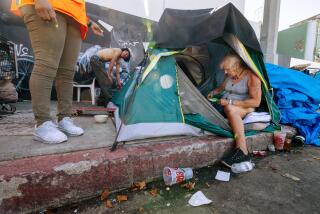India hurries to hide its poor
Reporting from New Delhi — The government people came one night in late September and built a partition covered with bright blue plastic sheeting and adorned with cartoonish tiger mascots and “Come Out and Play” slogans. It hid the slum known as Coolie Camp on the airport road where the foreigners pass.
Irfana Begum, 40, who collects garbage, must now lug her three-wheeled bicycle over about 300 feet of rocky ground to get to the road and make her living.
Begum, a 15-year resident of the slum, squatted in the dirt in a dusty sari, her bare feet adorned with toe rings. “They’re trying to pretend that poor people don’t exist in India, for their image,” she said near a pile of plastic and glass bottles, cardboard and used vinyl sheeting.
“It really makes us angry,” she said.
By hosting the Commonwealth Games, a mini- Olympics that begins Sunday and is to be attended by 71 nations, India hoped to propel New Delhi into the ranks of world-class cities such as London and New York and mirror Beijing’s hosting of the 2008 Olympics.
But amid bad planning, alleged corruption and shoddy workmanship, crews have barely finished the main sports venues, let alone various urban renewal projects. The result, residents and experts say, is an effort to hide the impoverished, including those in this slum near an athlete training center.
“I’m so appalled and angry at this,” said Harsh Mander, a member of the ruling party’s National Advisory Council after passing the cheerily camouflaged Coolie Camp. “Poverty is nothing to be ashamed of, but government and middle-class elements want to hide it.”
The government has tried to rid the capital of beggars, and has used two “mobile court” trailers, with police and judges in tow, that grab and sentence panhandlers. Many receive one-year detentions in “beggar homes” or are temporarily exiled to neighboring states, leading to bureaucratic squabbles over who they “belong to.”
Authorities have also cracked down on an estimated 300,000 street vendors, a significant burden on families who live hand to mouth. Daulat Ram, 50, a handicapped barber who lives in Coolie Camp, has seen his business decline precipitously since he was forced off the main road.
Most cities that host such mega-events resort to window dressing. Seoul expelled 720,000 people from their homes before the 1988 Olympics and shuttered dog-meat restaurants. Eight years later, Atlanta issued 9,000 arrest citations for the homeless. Athens removed hundreds of Roma, also known as Gypsies, before the 2004 Games.
China went even further before the 2008 Olympics, forcibly relocating about 1.25 million people, removing political “troublemakers” from the capital and tearing down traditional hutong neighborhoods.
Although India’s efforts for the Oct. 3-14 games pale by comparison, activists say they expected more from a nation that has long prided itself on its humanitarian policies. Civic groups said New Delhi’s anti-begging law, modeled on 1920s British colonial-era statutes, has been applied indiscriminately.
“It’s been used to catch anyone: a dirty man, a person without skills, someone who’s just hungry,” said Sanjay Kumar, an activist with a civic group working with the homeless. “These aren’t offenders. They’re victims.”
The municipal social welfare minister, Mangat Ram Singhal, told local reporters: “When we make Delhi a world-class city, it will be compared with other world capitals. One does not come across beggars in other countries. Why should there be beggars in Delhi?”
Poverty and begging in India traditionally were nothing to be ashamed of, but the push to hide them reflects the changing values of the members of an emerging middle class, said the advisory council’s Mander.
“It should be more important what we’re doing than how we’re seen,” Mander said.
The blue Commonwealth Games partitions, made of vinyl, wood and steel, follow earlier plans to shield “unsightly” areas with bamboo screens. One legislator even proposed screening off the entire fetid Yamuna River. The suggestions produced an outcry in parliament and were eventually dropped, only to see the idea revived in its present form.
The move to hide parts of the city underscores why India should change its approach to urbanization, said Jeb Brugmann, a Toronto-based urban planning consultant and author of a book on Mumbai’s slums.
Rather than view shantytowns as embarrassments to be bulldozed or hidden, the government should support them with sanitation and basic services, knowing that — as happened in London and New York a century ago — these areas could eventually become middle-class communities.
“Slum residents are investing billions of dollars in small increments,” Brugmann said. “The Indian government needs to harness that.”
Back at the Coolie Camp slum, Begum’s neighbor, Lakshmi, a maid who uses one name, bemoaned the growing social divide.
“The rich are getting richer and nothing’s left for the poor,” she said. “We’re treated like garbage.”
Begum looked over at the barricade, which has forced her children to walk farther to collect refuse and means they miss their lunch.
“We’ll just put up with it for the next several days,” she said. “If they don’t take the barrier away afterward, maybe we can recycle the wood and the plastic and make a little money.”
Anshul Rana in The Times’ New Delhi Bureau contributed to this report.
More to Read
Sign up for Essential California
The most important California stories and recommendations in your inbox every morning.
You may occasionally receive promotional content from the Los Angeles Times.










